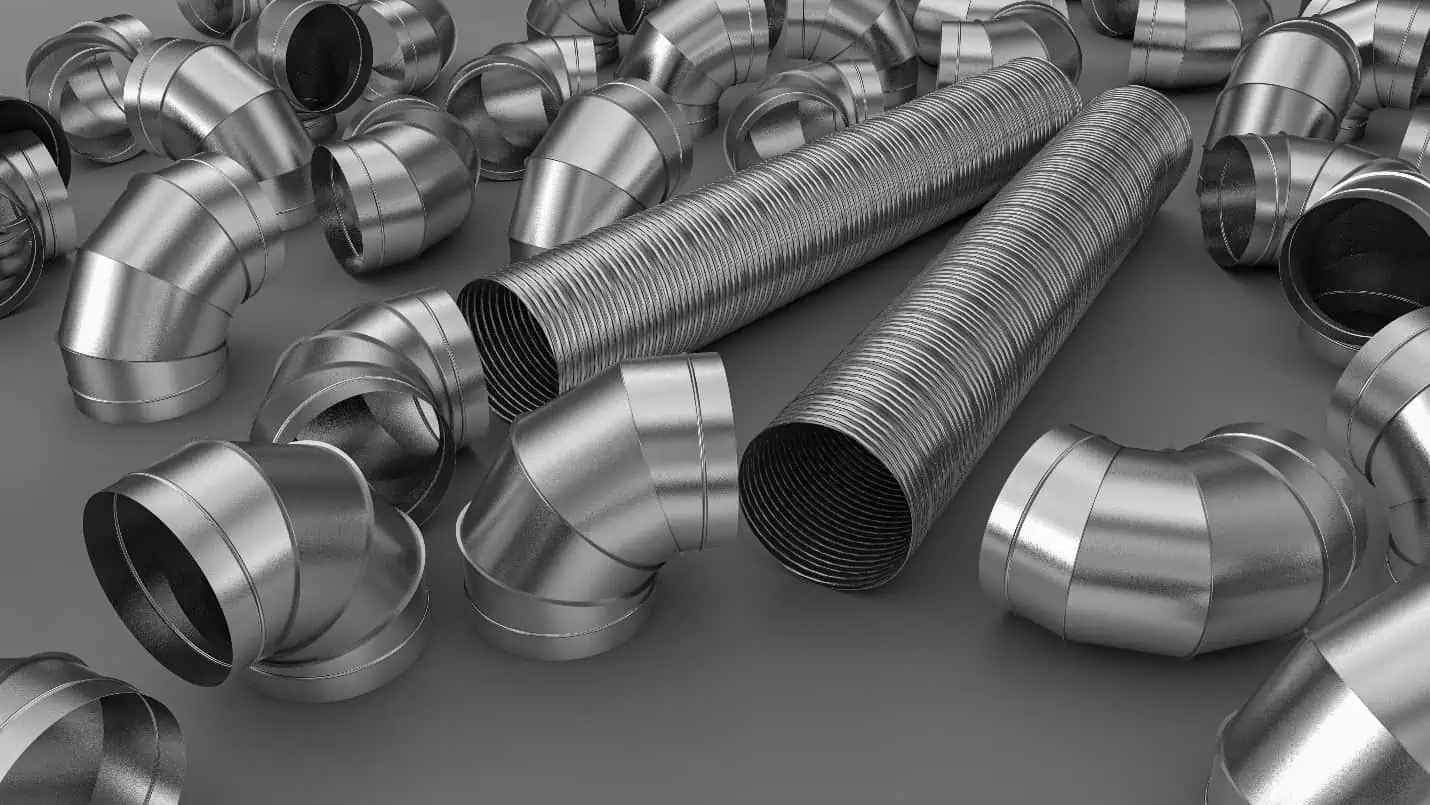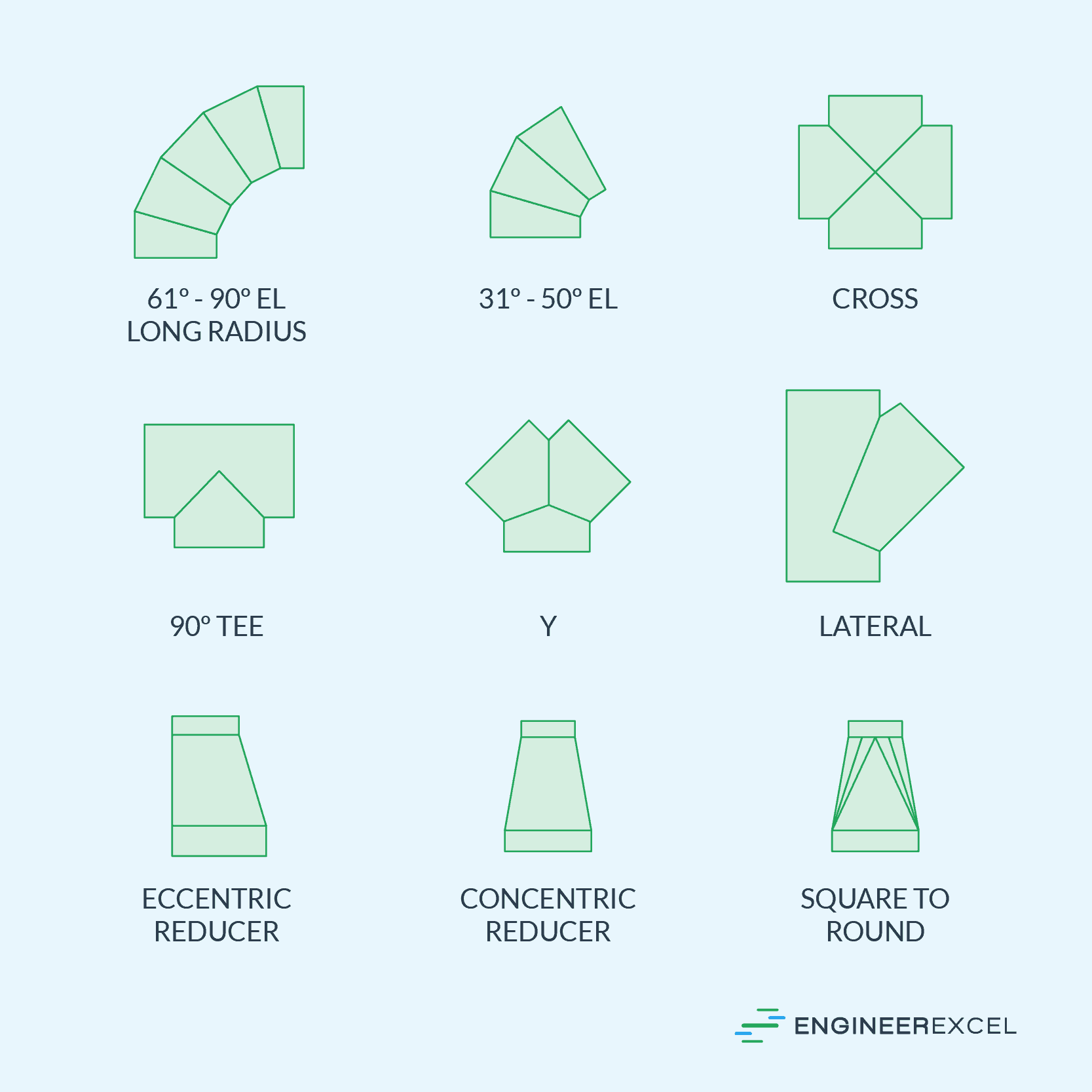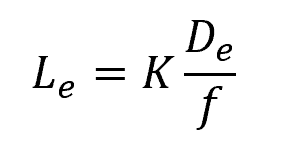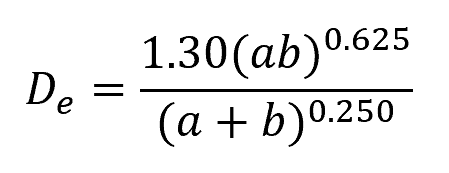When designing ducted heating, ventilation, and air conditioning systems, it is important to account for pressure losses in order to size the fan and air-handling equipment properly. Duct fittings like elbows and tees contribute to these pressure losses.

This article focuses on using the equivalent length method to quantify the pressure losses resulting from duct fittings.
Equivalent Length Of Duct Fittings Explained
Ducts serve as conduits in HVAC systems that are used for distributing, delivering, and removing air within building spaces. To ensure efficient airflow and proper distribution throughout the different areas of a building, ducts are typically laid out and interconnected using duct fittings.
Some of the most common duct fittings include elbows, crosses, tees, wyes, laterals, reducers, and transitions, as illustrated in the diagram below:

Elevate Your Engineering With Excel
Advance in Excel with engineering-focused training that equips you with the skills to streamline projects and accelerate your career.

Like ducts, duct fittings contribute to the total pressure loss in an HVAC system. While pressure loss from ducts is caused by friction as air flows through the entire duct length, pressure loss from duct fittings is primarily caused by changes in momentum as the flow of air changes direction and velocity across the fittings.
These pressure losses can be significant and must be accurately evaluated in order to properly size the necessary air handling equipment. Ignoring pressure losses could lead to an undersized equipment, causing reduced system performance and discomfort for building occupants.
There are two common methods of expressing the dynamic losses of duct fittings: the dynamic loss coefficient method and the equivalent length of duct method. In the equivalent length of duct method, the dynamic pressure loss of fittings is replaced with a length of straight duct that would theoretically yield the same pressure loss under the same flow conditions.

In other words, it converts the pressure drop caused by a fitting into an equivalent length of straight duct, allowing the fitting to be analyzed in the same terms as the straight duct. Different fittings have varying equivalent lengths, which depend on factors such as the fitting’s geometry, size, and the airflow velocity passing through it.
Equivalent Length Method
The concept of equivalent length is especially useful when sizing air handling equipment. Normally, an air handling equipment is sized based on the critical duct path, which represents the path with the highest cumulative pressure losses from the air handler to the room terminal.
To find the critical duct path, the equivalent lengths of fittings and measured lengths of straight ducts along each path are summed up. The highest sum obtained is the hypothetical total length that would yield the highest total pressure loss, as shown in the formula:

Where:
- Ltotal = hypothetical total length of duct [m]
- Le = equivalent length of each duct fitting [m]
- Lduct = actual length of straight ducts [m]
The total pressure loss along the critical path is then calculated using the Darcy equation as shown below:

Where:
- ΔPtotal = total pressure loss [Pa]
- f = Darcy-Weisbach friction factor [unitless]
- De = equivalent diameter of the duct [m]
- ρ = air density [kg/m3]
- V = air velocity [m/s]
The Darcy-Weisbach friction factor is a dimensionless quantity used to quantify the amount of frictional resistance encountered by air flowing through the duct. For turbulent flow, its value depends on the roughness of the duct’s inner surface and the Reynolds number. In practice, it is estimated using the Moody diagram.
Notice that the chart above indicates friction loss. Since the dynamic losses from duct fittings have already been converted to equivalent lengths of straight ducts, it is now possible to treat them as friction losses.
Calculating The Equivalent Length Of A Duct Fitting
Traditionally, the dynamic pressure loss across a duct fitting is calculated using the following formula:

Where:
- ΔPd = dynamic pressure loss across a duct fitting [Pa]
- K = dynamic loss coefficient of the duct fitting [unitless]
Since flow through duct fittings is complex in nature, and a theoretical analysis is generally not plausible, pressure loss is characterized using an experimentally obtained dimensionless parameter called the dynamic loss coefficient. ASHRAE Handbook—Fundamentals lists the dynamic loss coefficients of some of the most common duct fittings.
For example, the dynamic loss coefficients of die stamped elbows (r/D = 1.5) are shown below:

From the dynamic pressure loss equation above, the formula for the equivalent length can be derived by equating it with the Darcy equation:

Cancelling out the velocity head, the formula for the equivalent length of a duct fitting becomes:

Note that not all ducts are circular; hence, the use of equivalent diameter. The equivalent diameter of a non-circular duct is the diameter of a hypothetical circular duct that would have the same pressure loss and flow characteristics.
For rectangular ducts, the formula for the equivalent length was developed by Huebscher:

Where:
- a = length of one side of the duct [m]
- b = length of the adjacent side [m]
For flat oval ducts, the formula for the equivalent length was developed by Heyt and Diaz:

Where:
- A = major axis of the flat oval duct [m]
- a = minor axis of the flat oval duct [m]
